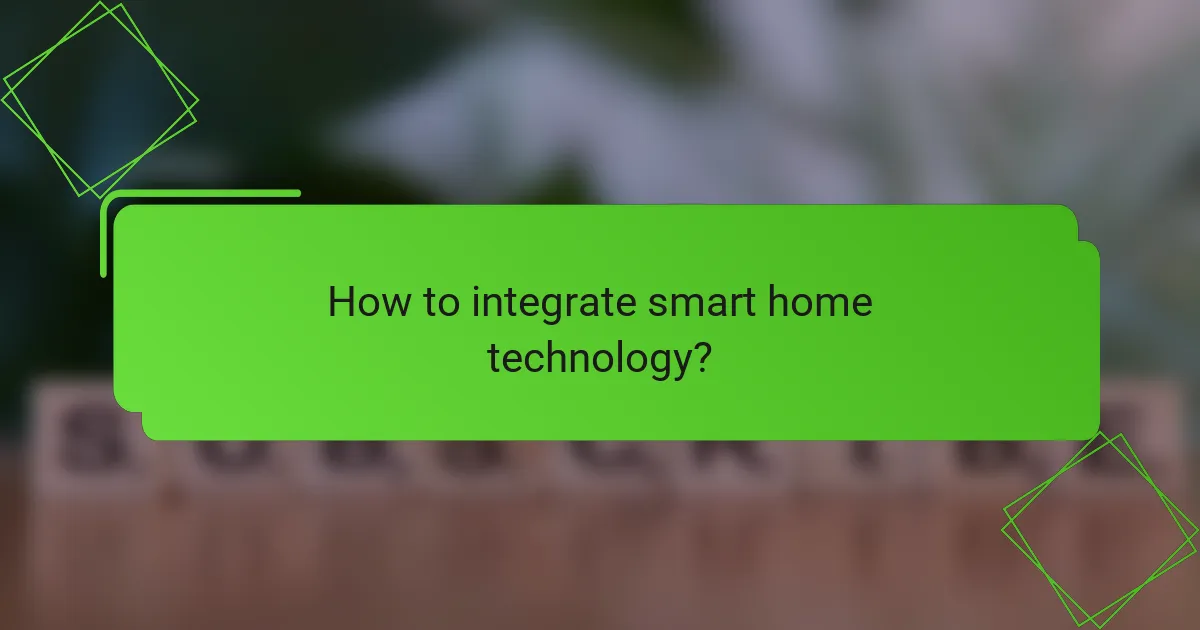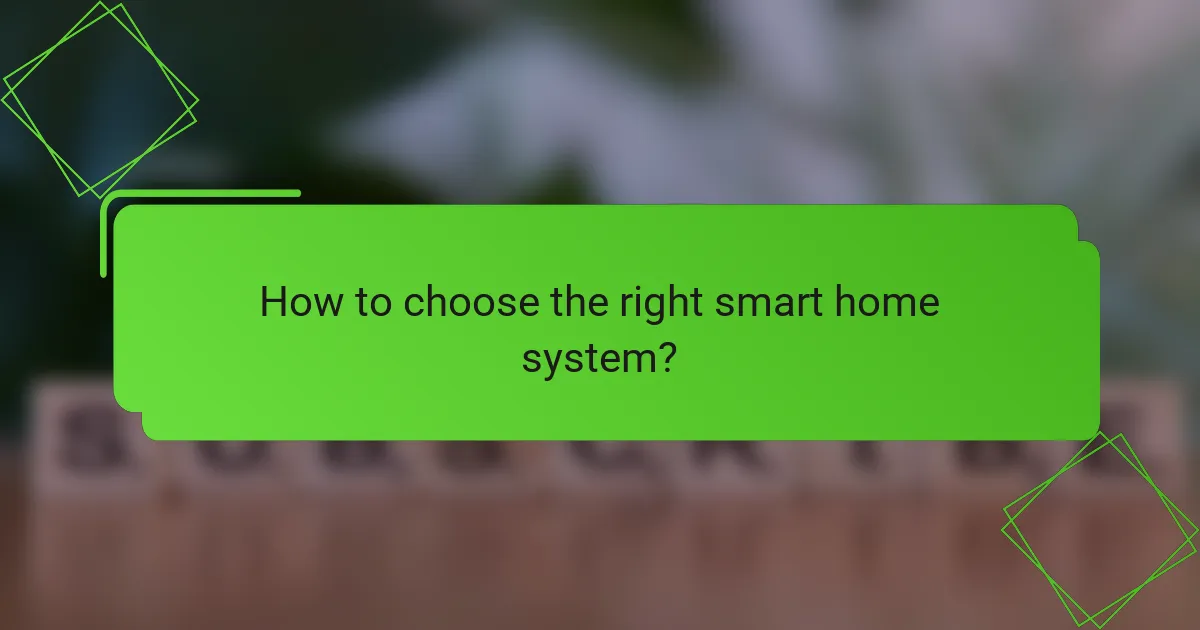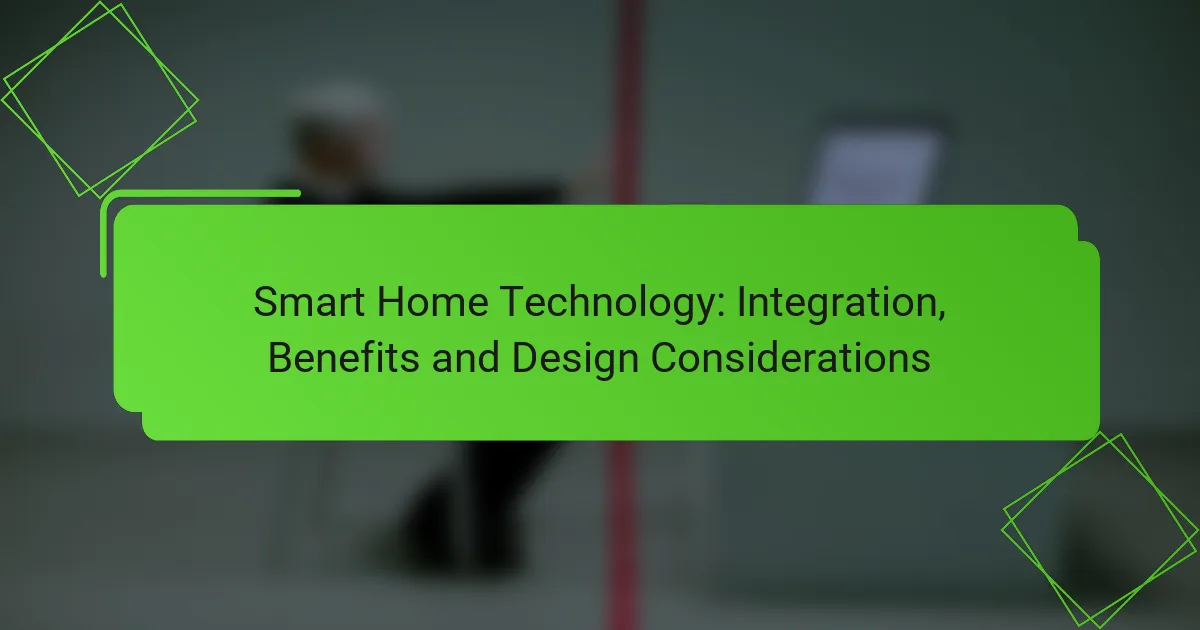Smart home technology is revolutionizing the way we live, offering enhanced energy efficiency, security, and convenience. By integrating various devices, homeowners can create a seamless environment that not only improves daily life but also potentially increases property values. Thoughtful design considerations, such as layout, wiring, and device placement, are essential for ensuring that these technologies function harmoniously within the home.

What are the benefits of smart home technology in Ireland?
Smart home technology in Ireland offers numerous advantages, including improved energy efficiency, enhanced security, and increased convenience. These benefits contribute to a more comfortable living environment while potentially raising property values.
Energy efficiency
Smart home devices can significantly reduce energy consumption by optimizing heating, lighting, and appliance use. For instance, smart thermostats learn your schedule and adjust temperatures accordingly, potentially saving up to 20% on heating bills.
Additionally, smart lighting systems can automatically turn off when no one is in a room, further conserving energy. Homeowners should consider integrating energy monitoring systems to track usage and identify areas for improvement.
Enhanced security
Smart home technology enhances security through devices like smart locks, cameras, and alarm systems. These devices allow homeowners to monitor their property remotely and receive alerts about suspicious activities.
For example, a smart doorbell camera can notify you when someone approaches your home, allowing for real-time interaction. Investing in a comprehensive security system can deter potential intruders and provide peace of mind.
Convenience and automation
Smart home technology simplifies daily tasks through automation. Homeowners can schedule appliances, control lighting, and adjust thermostats with voice commands or smartphone apps, making life more convenient.
For example, you can set your coffee maker to start brewing at a specific time each morning. This level of automation not only saves time but also enhances the overall living experience.
Increased property value
Integrating smart home technology can increase property value, making homes more attractive to potential buyers. Features such as smart security systems, energy-efficient appliances, and automated lighting are appealing selling points.
According to some estimates, homes with smart technology can sell for 5-10% more than comparable homes without these features. Investing in smart upgrades can yield a good return when selling your property.
Improved accessibility
Smart home technology can greatly enhance accessibility for individuals with disabilities or mobility challenges. Devices like voice-activated assistants and smart home controls allow for easier management of home environments.
For instance, smart lighting and thermostats can be adjusted without physical effort, making daily tasks more manageable. Homeowners should explore options that cater to specific accessibility needs, ensuring a comfortable living space for everyone.

How to integrate smart home technology?
Integrating smart home technology involves connecting various devices to work together seamlessly, enhancing convenience and efficiency. This process typically includes selecting compatible devices, setting up a central hub, connecting devices via Wi-Fi, and utilizing smart assistants.
Choosing compatible devices
When selecting smart home devices, ensure they are compatible with each other and your chosen ecosystem, such as Google Home or Amazon Alexa. Look for devices that support common standards like Zigbee or Z-Wave, which facilitate communication between different brands.
Consider the types of devices you need, such as smart lights, thermostats, or security cameras. Research user reviews and compatibility lists to avoid purchasing devices that may not integrate well with your existing setup.
Setting up a central hub
A central hub acts as the brain of your smart home, allowing devices to communicate and be controlled from a single interface. Popular hubs include Samsung SmartThings and Hubitat, which support a wide range of devices and protocols.
When setting up a hub, follow the manufacturer’s instructions for installation and configuration. Ensure it is placed in a central location within your home to maximize connectivity with all devices.
Connecting devices via Wi-Fi
Most smart home devices connect to your home network via Wi-Fi, enabling remote control and automation. Make sure your Wi-Fi network is robust and secure, ideally using a dual-band router to support multiple devices without interference.
During setup, follow the device-specific instructions to connect each device to your Wi-Fi. Keep in mind that some devices may require a dedicated app for initial setup, so download these apps beforehand.
Utilizing smart assistants
Smart assistants like Amazon Alexa, Google Assistant, or Apple Siri enhance your smart home experience by allowing voice control and automation. These assistants can help you manage tasks, control devices, and create routines for daily activities.
To utilize smart assistants effectively, link them to your smart home devices through their respective apps. Create voice commands for common tasks, such as adjusting the thermostat or turning off lights, to streamline your daily routines.

What design considerations are important for smart homes?
Key design considerations for smart homes include layout and space planning, wiring and infrastructure, device placement, and future-proofing. These elements ensure that smart technology integrates seamlessly into the home while providing convenience and efficiency.
Layout and space planning
Effective layout and space planning are crucial for optimizing the functionality of smart homes. Consider open floor plans that facilitate connectivity and allow for easy access to devices. Ensure that common areas, such as living rooms and kitchens, are equipped with smart technology for enhanced usability.
When planning the layout, think about how people move through the space. Position smart devices in locations that are easily accessible, such as near power outlets and Wi-Fi routers, to enhance their effectiveness.
Wiring and infrastructure
Robust wiring and infrastructure form the backbone of any smart home. Use high-quality wiring to support the bandwidth needs of multiple devices, especially for high-definition video streaming or gaming. Consider installing Ethernet cabling in addition to Wi-Fi to ensure stable connections.
It’s advisable to consult with professionals to assess the existing electrical system and make necessary upgrades. Compliance with local electrical codes is essential to ensure safety and functionality.
Device placement
Strategic device placement enhances the performance of smart home technology. Place smart speakers and hubs in central locations to maximize their range and effectiveness. Avoid placing devices near metal objects or thick walls that can obstruct signals.
Consider the purpose of each device when deciding where to place it. For example, security cameras should be positioned to cover entry points, while smart thermostats should be located away from direct sunlight or drafts for accurate temperature readings.
Future-proofing
Future-proofing involves designing your smart home to accommodate new technologies as they emerge. Choose devices that are compatible with multiple platforms and standards to ensure longevity. Investing in modular systems can allow for easy upgrades and expansions.
Stay informed about industry trends and anticipate potential advancements in smart technology. Planning for scalability can save costs and minimize disruptions when integrating new devices in the future.

What are the best smart home devices available in Ireland?
The best smart home devices in Ireland include a range of products that enhance convenience, security, and energy efficiency. Popular options feature smart lighting, thermostats, voice assistants, and security cameras, each designed to integrate seamlessly into your home environment.
Philips Hue lighting
Philips Hue lighting offers a versatile smart lighting solution that allows users to control their home lighting through a smartphone app or voice commands. These LED bulbs can change colors, dim, and be scheduled to turn on or off, providing both ambiance and energy savings.
When choosing Philips Hue, consider the starter kits that include a bridge for connectivity. The system is compatible with various smart home platforms, making it easy to integrate with existing devices. Ensure your Wi-Fi network can support the additional devices for optimal performance.
Nest Thermostat
The Nest Thermostat is an intelligent device that learns your heating and cooling preferences to optimize energy use. It can be controlled remotely via a mobile app, allowing you to adjust your home’s temperature from anywhere, which can lead to significant savings on energy bills.
Installing the Nest Thermostat typically requires a compatible heating system, so check your setup before purchasing. The device also features eco-friendly settings and can provide energy usage reports, helping you make informed decisions about your energy consumption.
Amazon Echo
The Amazon Echo is a smart speaker that uses Alexa, Amazon’s voice assistant, to perform a variety of tasks. Users can play music, control smart home devices, set reminders, and access information using simple voice commands, making it a central hub for home automation.
When selecting an Amazon Echo, consider the different models available, such as Echo Dot for smaller spaces or Echo Show with a screen for video calls and recipes. Ensure compatibility with your other smart devices to maximize its functionality and convenience.
Ring Video Doorbell
The Ring Video Doorbell enhances home security by allowing you to see and speak to visitors at your door via a smartphone app. It features motion detection, HD video, and two-way audio, providing peace of mind whether you are home or away.
Installation is straightforward, requiring a Wi-Fi connection and a power source. Consider the subscription plan for cloud storage of video footage, which can be useful for reviewing past events. Ensure your Wi-Fi signal is strong at the door location for optimal performance.

How to choose the right smart home system?
Choosing the right smart home system involves assessing your specific needs, compatibility with existing devices, and budget. Consider factors like ease of use, security features, and the range of devices supported to ensure a seamless integration into your home.
Assess your needs
Start by identifying which areas of your home you want to automate. Common categories include lighting, security, climate control, and entertainment. Prioritize your needs based on daily routines and lifestyle to determine which systems will provide the most value.
For instance, if security is a top concern, focus on systems that offer robust surveillance options, such as cameras and smart locks. If energy efficiency is a priority, look for smart thermostats and lighting solutions that can help reduce utility costs.
Compatibility with existing devices
Ensure that the smart home system you choose is compatible with your current devices. Many systems operate on specific protocols like Zigbee, Z-Wave, or Wi-Fi, so check if your existing gadgets can integrate smoothly. This compatibility will save you from additional costs associated with replacing devices.
For example, if you already have smart bulbs that use Zigbee, consider a hub that supports this protocol. This way, you can control all your devices from a single app, enhancing convenience and functionality.
Budget considerations
Your budget will significantly influence your choice of a smart home system. Prices can vary widely, from basic setups costing a few hundred dollars to comprehensive systems that may run into the thousands. Determine how much you are willing to invest initially and for ongoing costs, such as subscriptions or additional devices.
Keep in mind that while some systems may have a higher upfront cost, they might offer long-term savings through energy efficiency or enhanced security features. Look for systems that provide a good balance between cost and functionality to maximize your investment.



